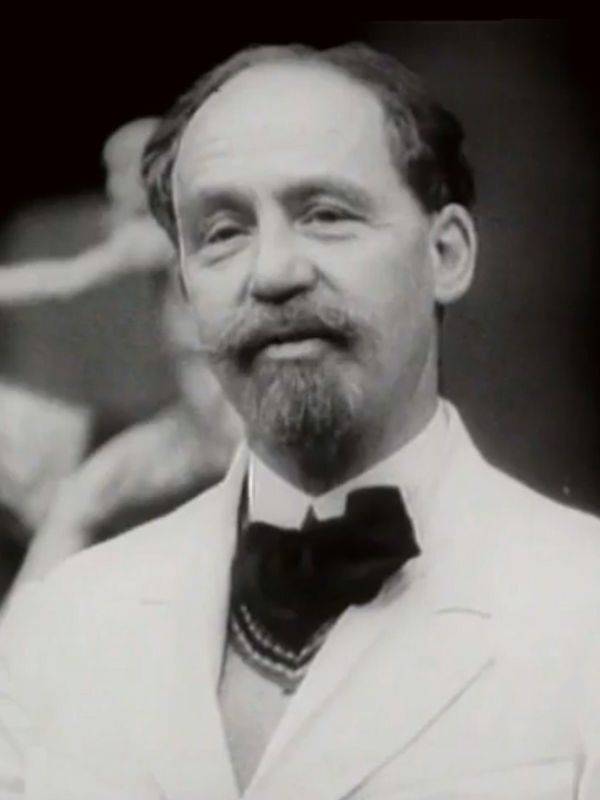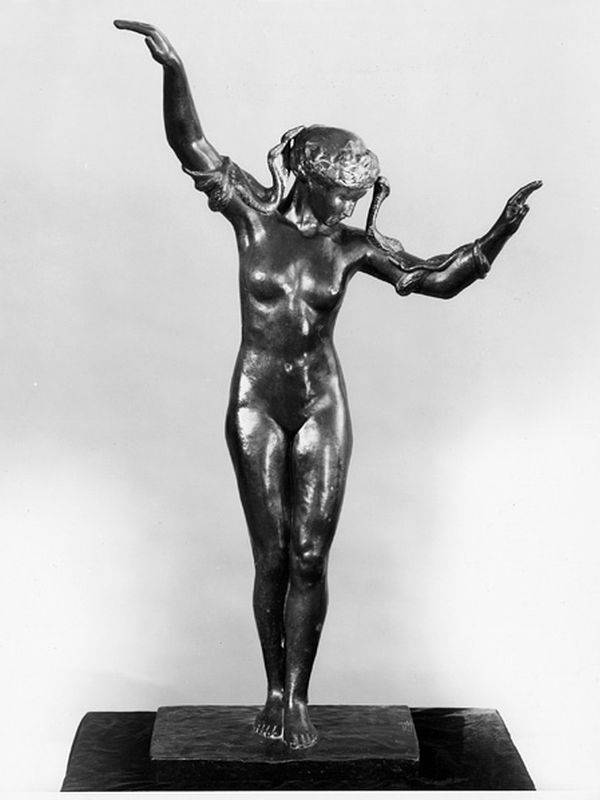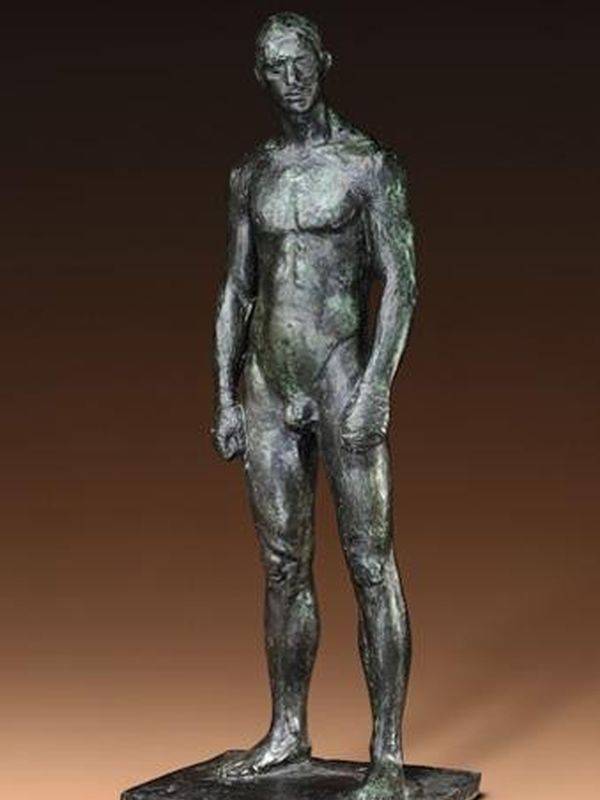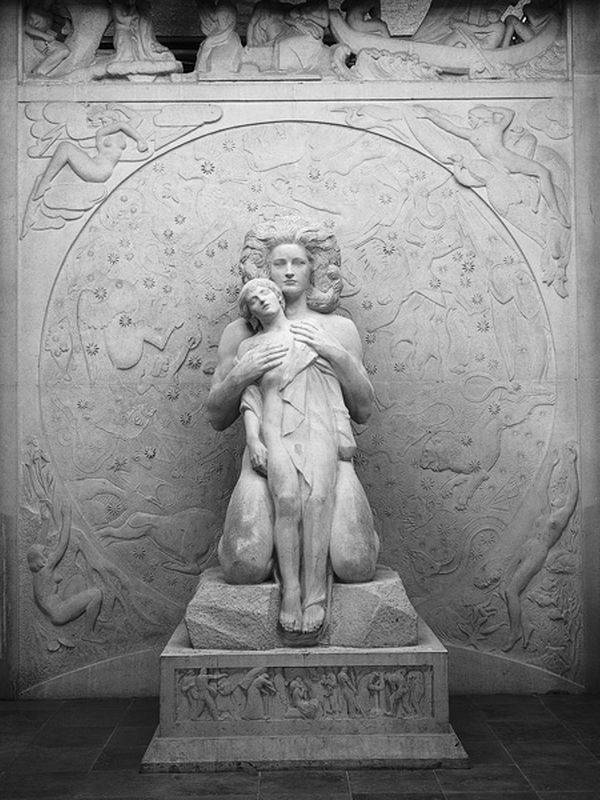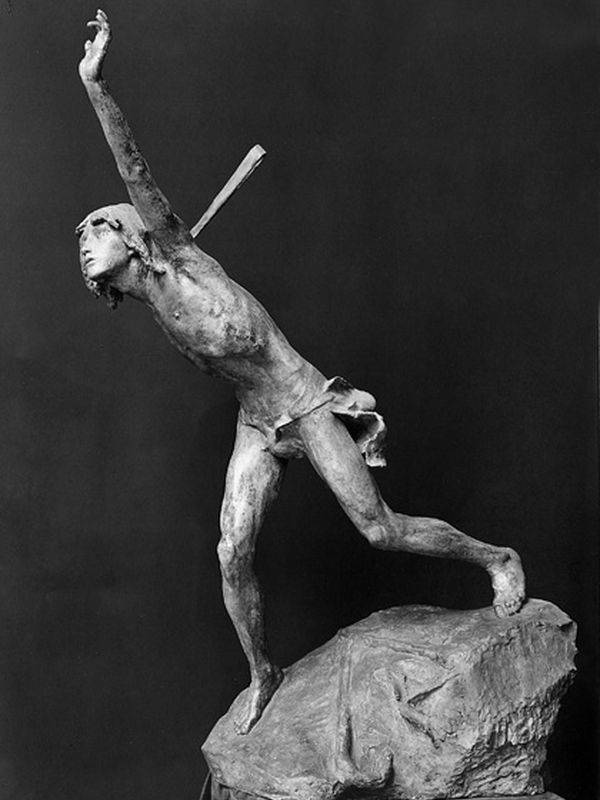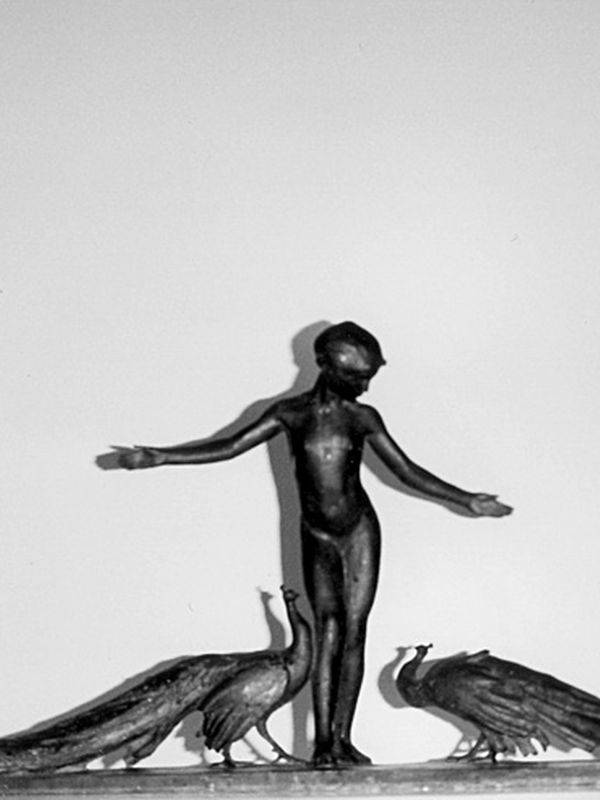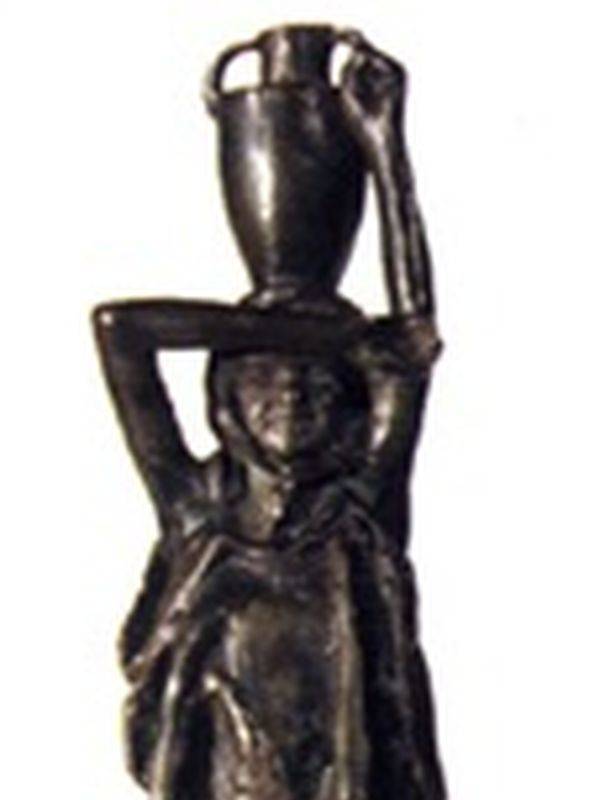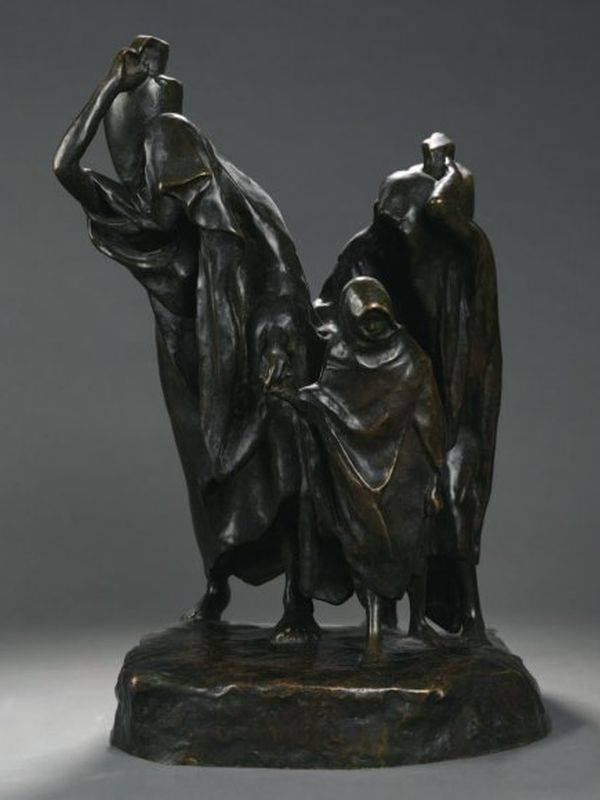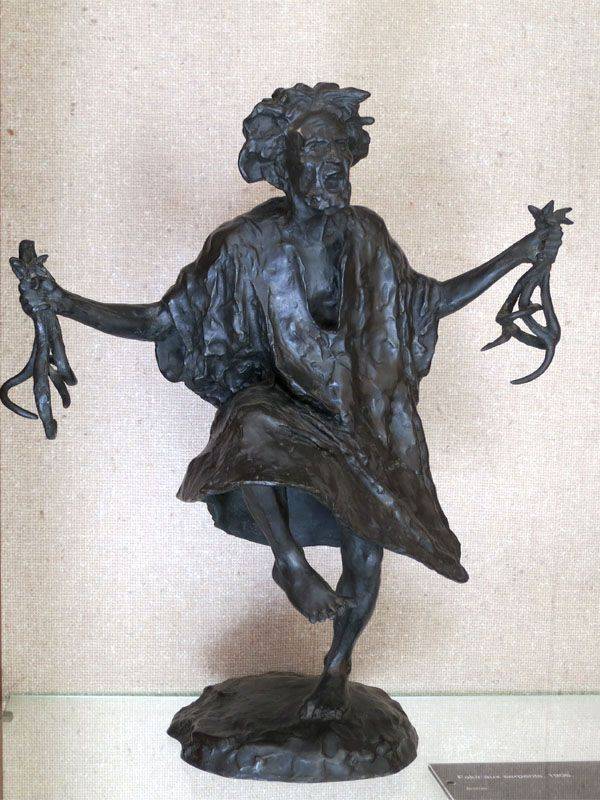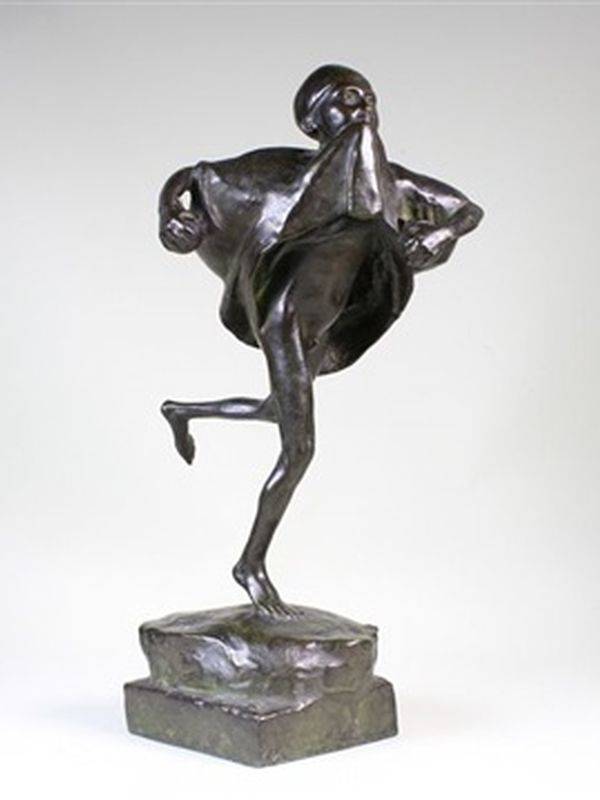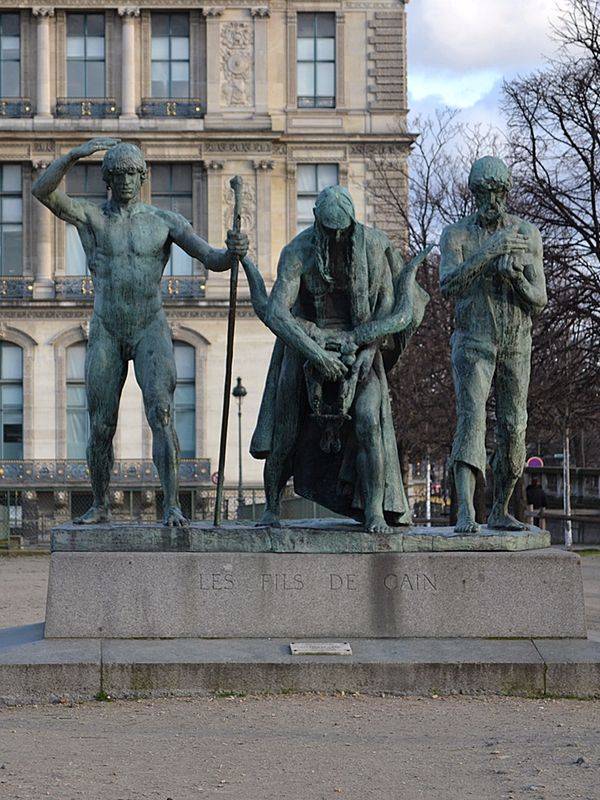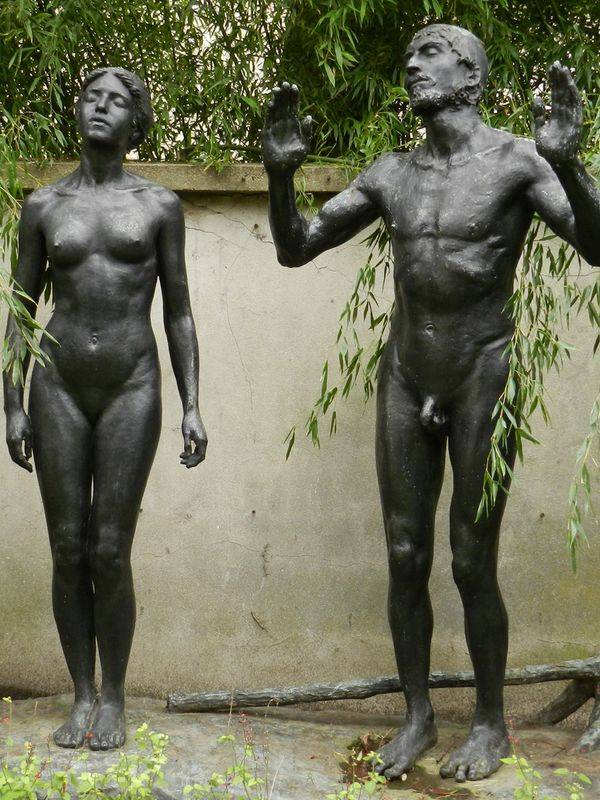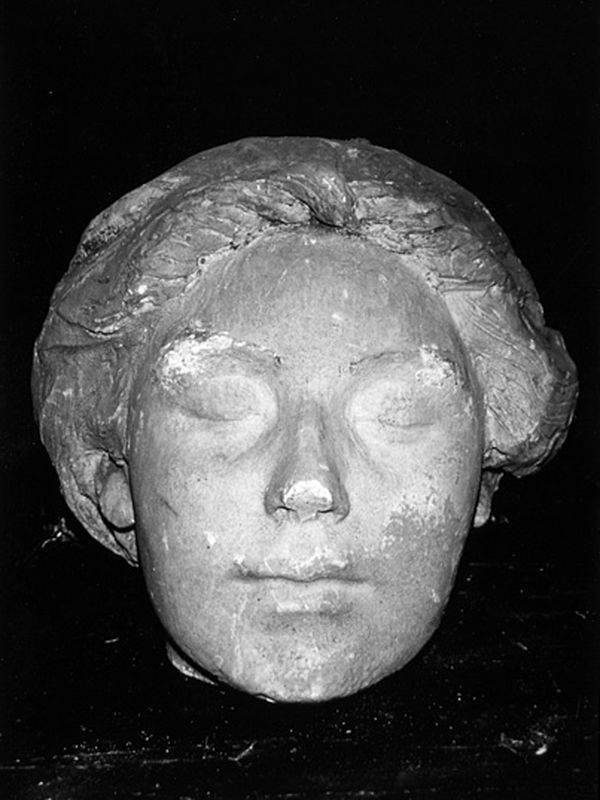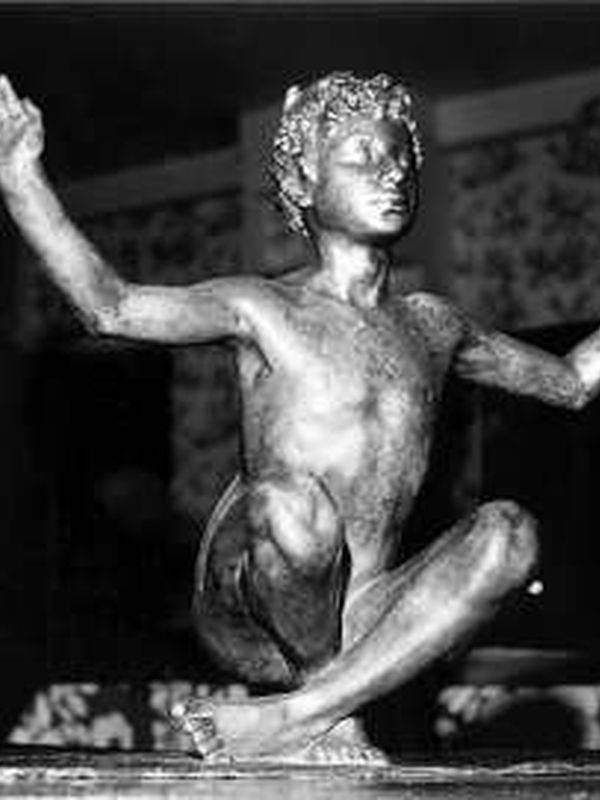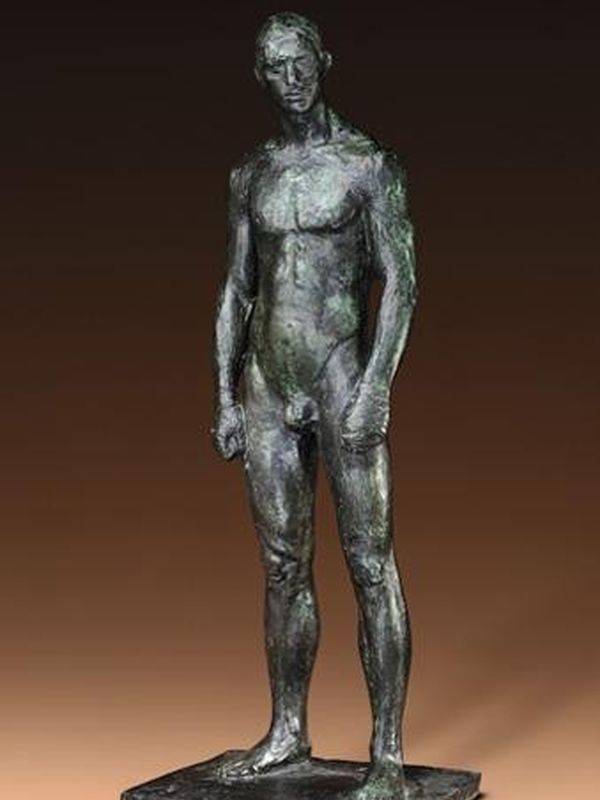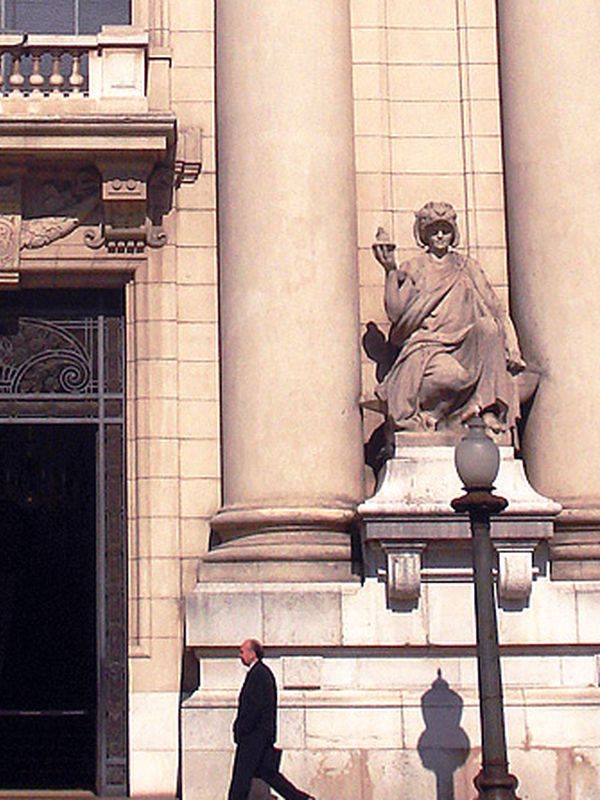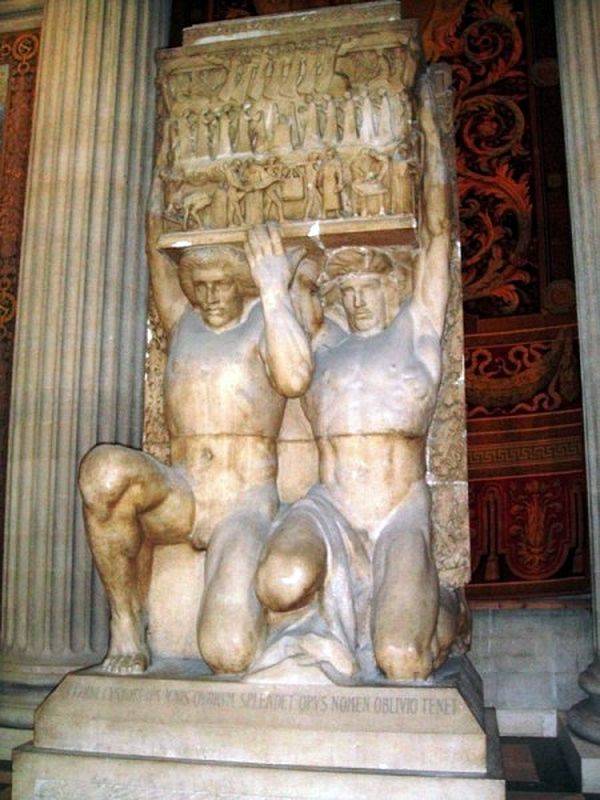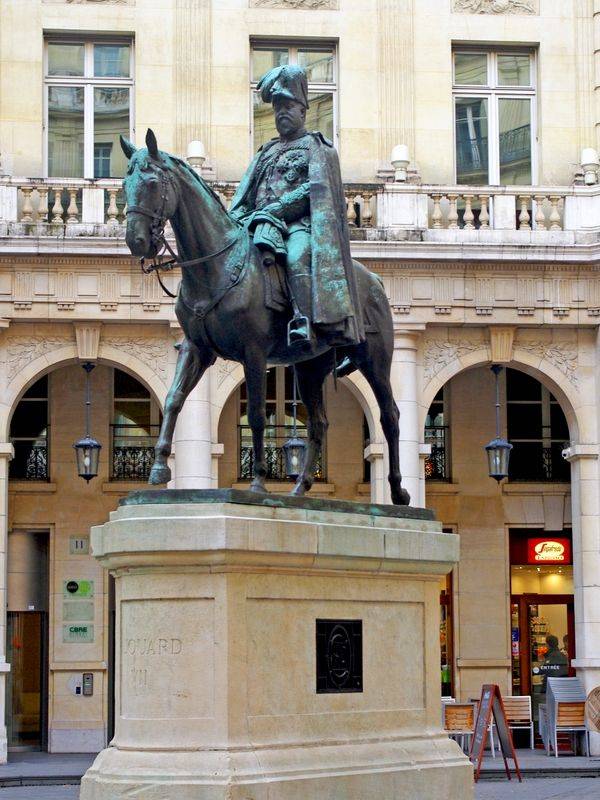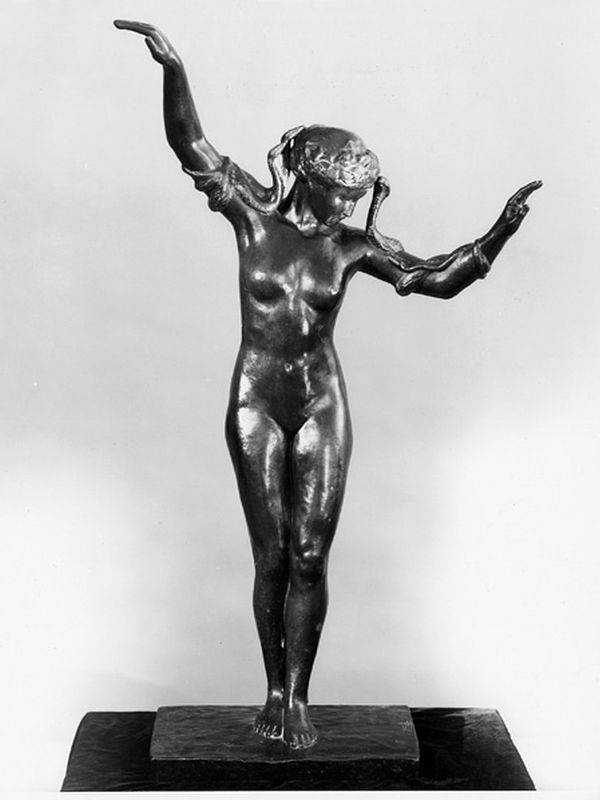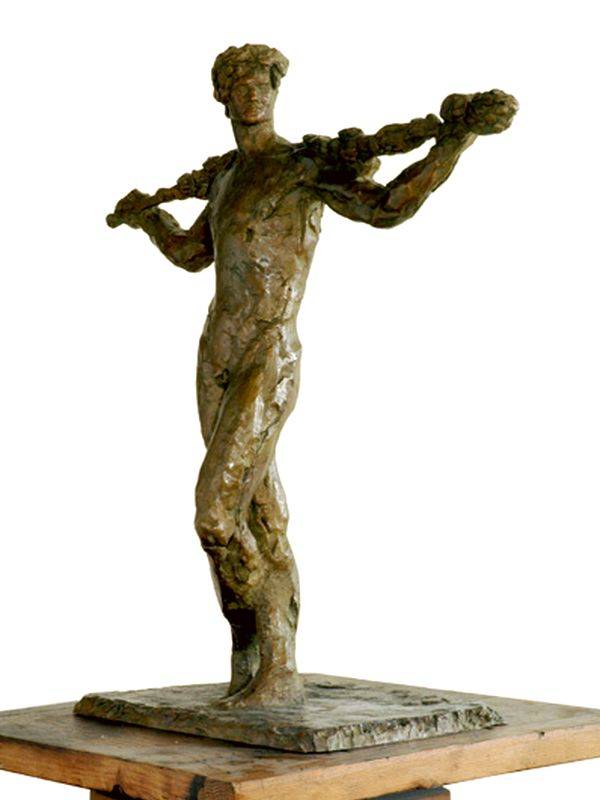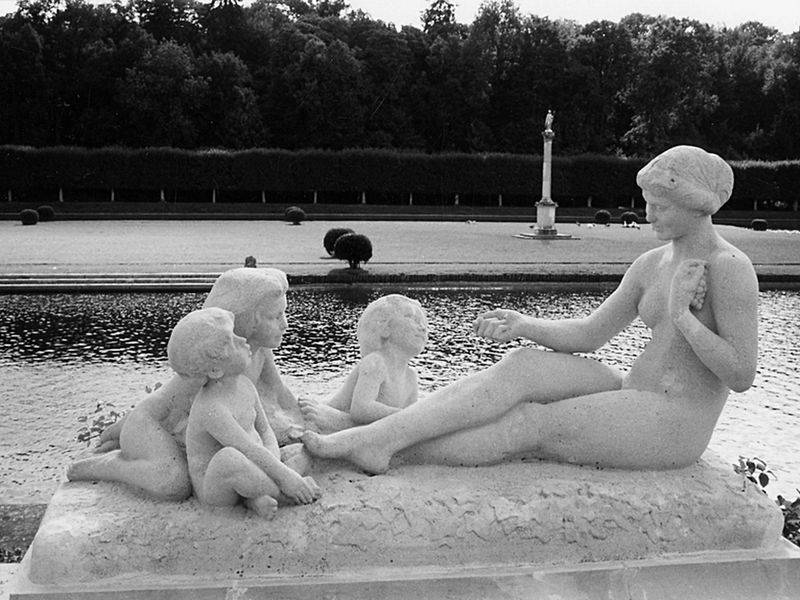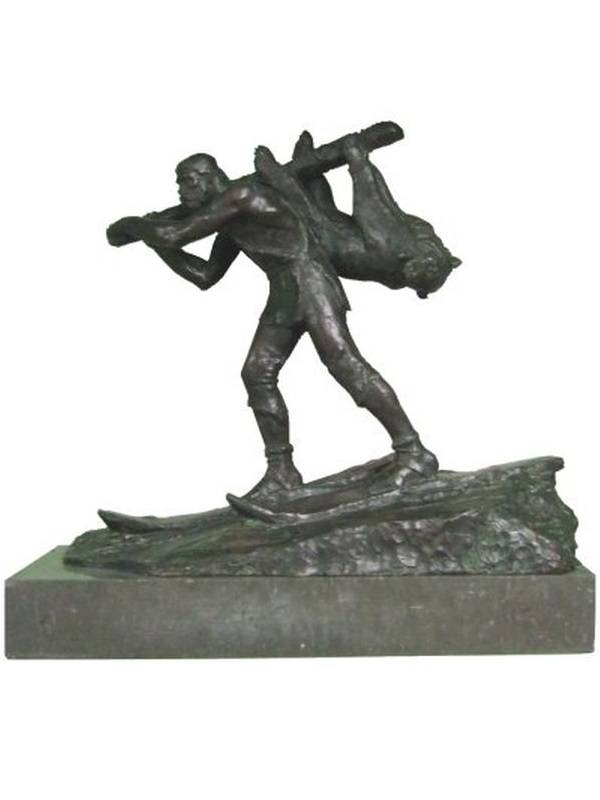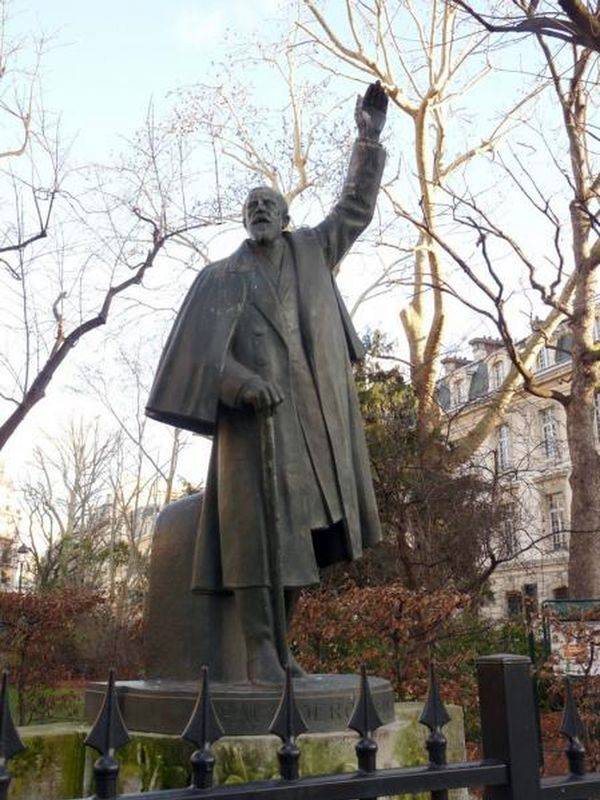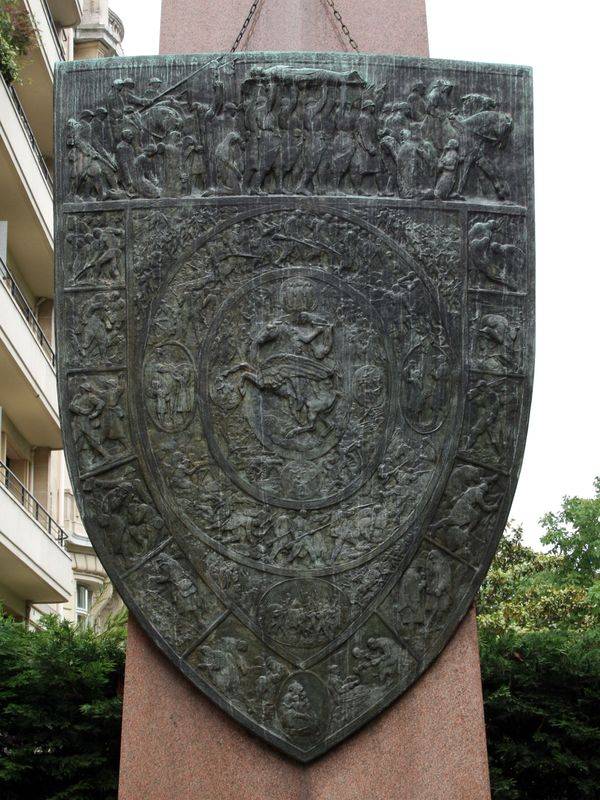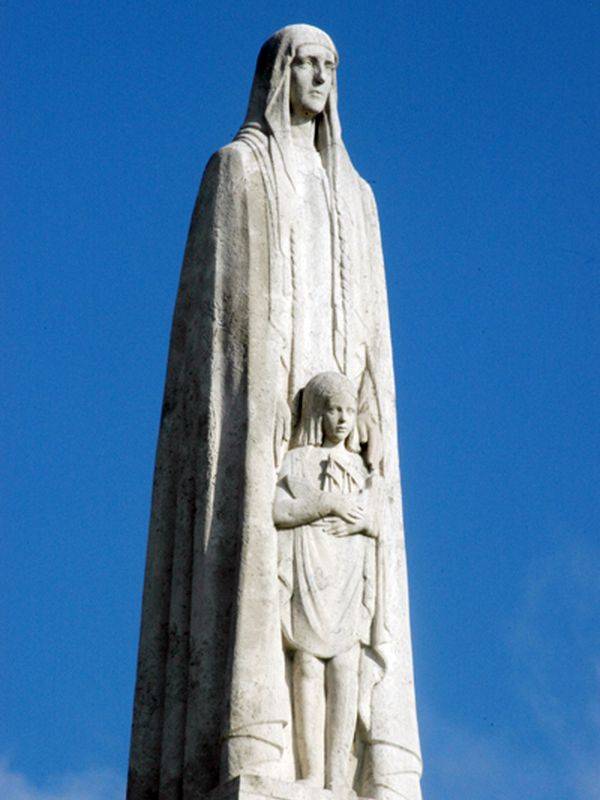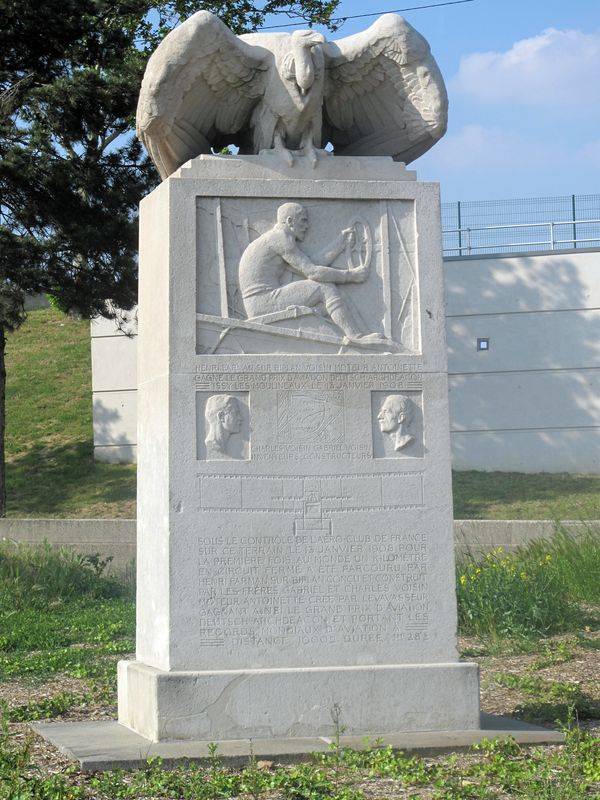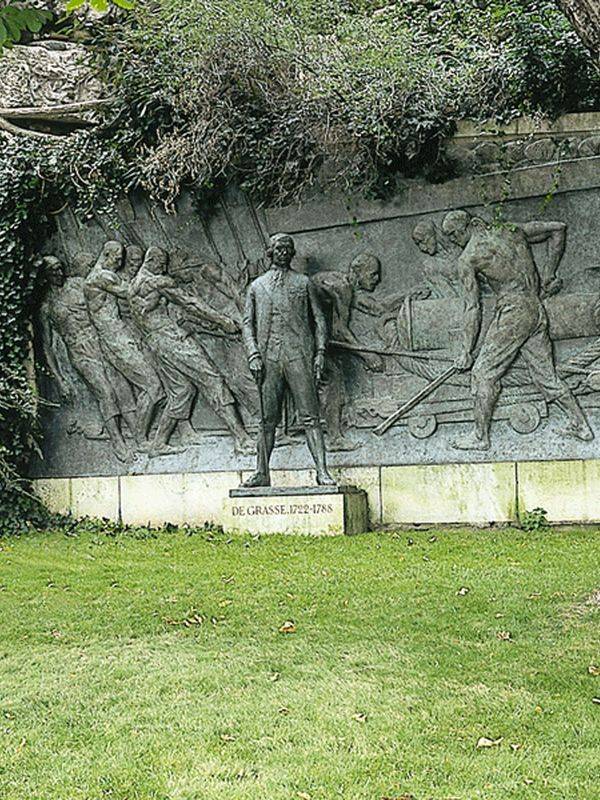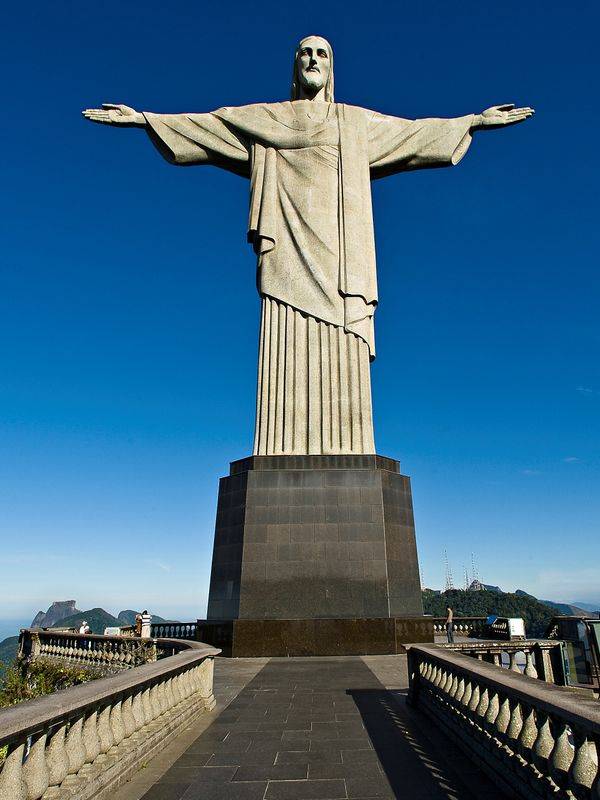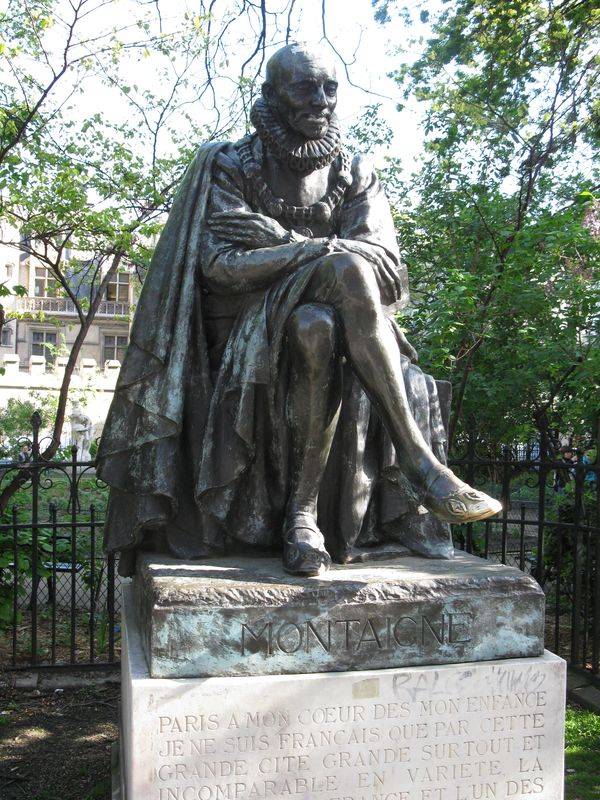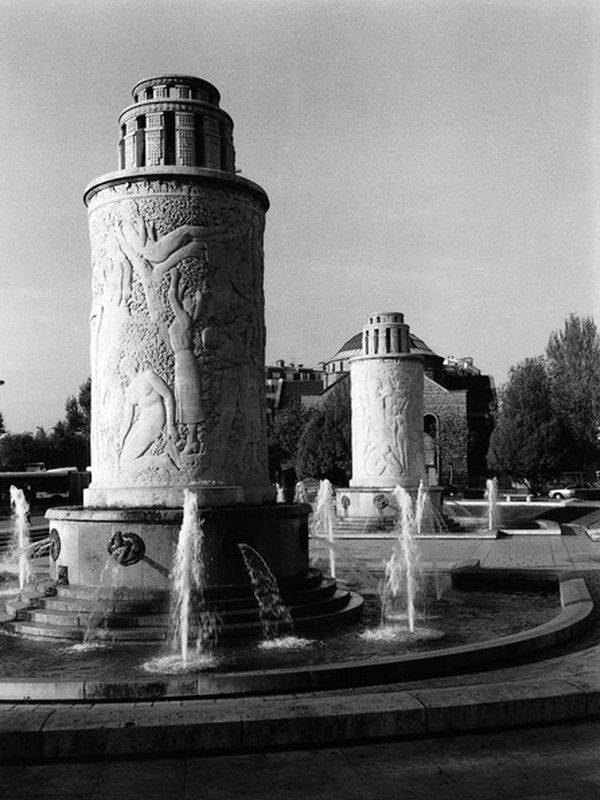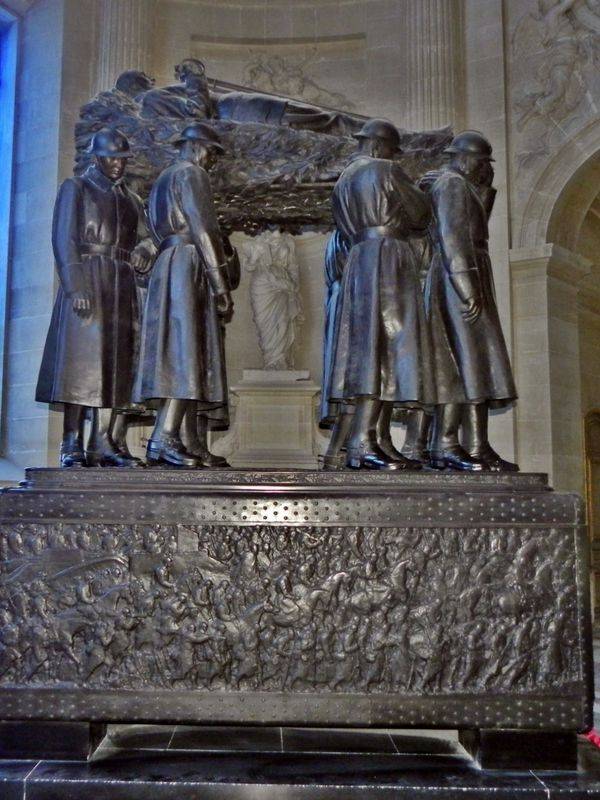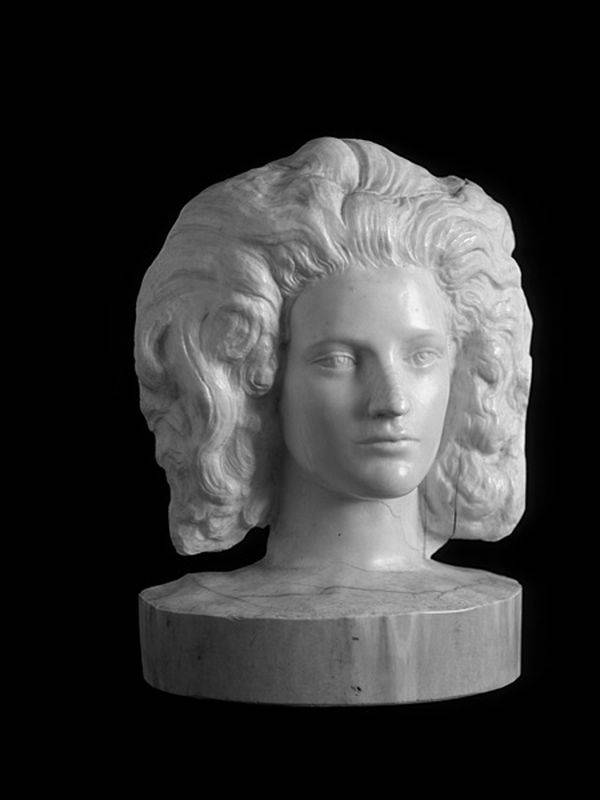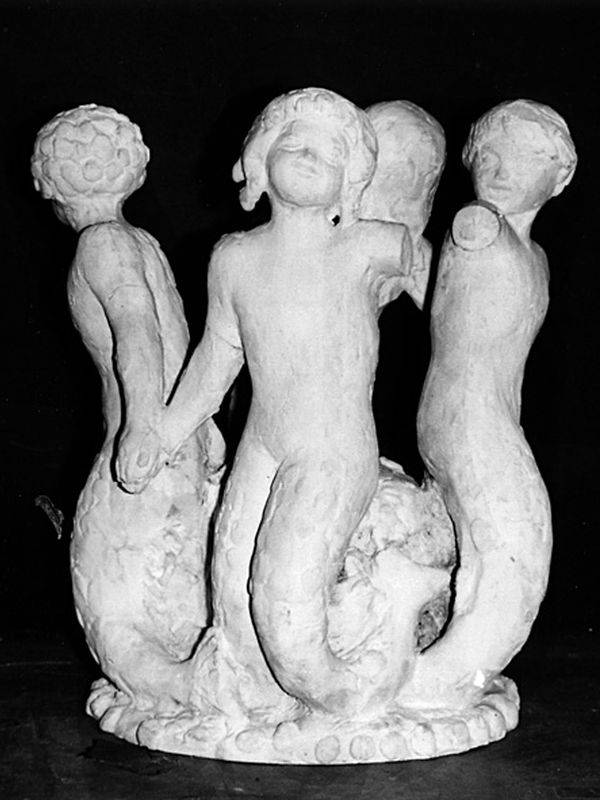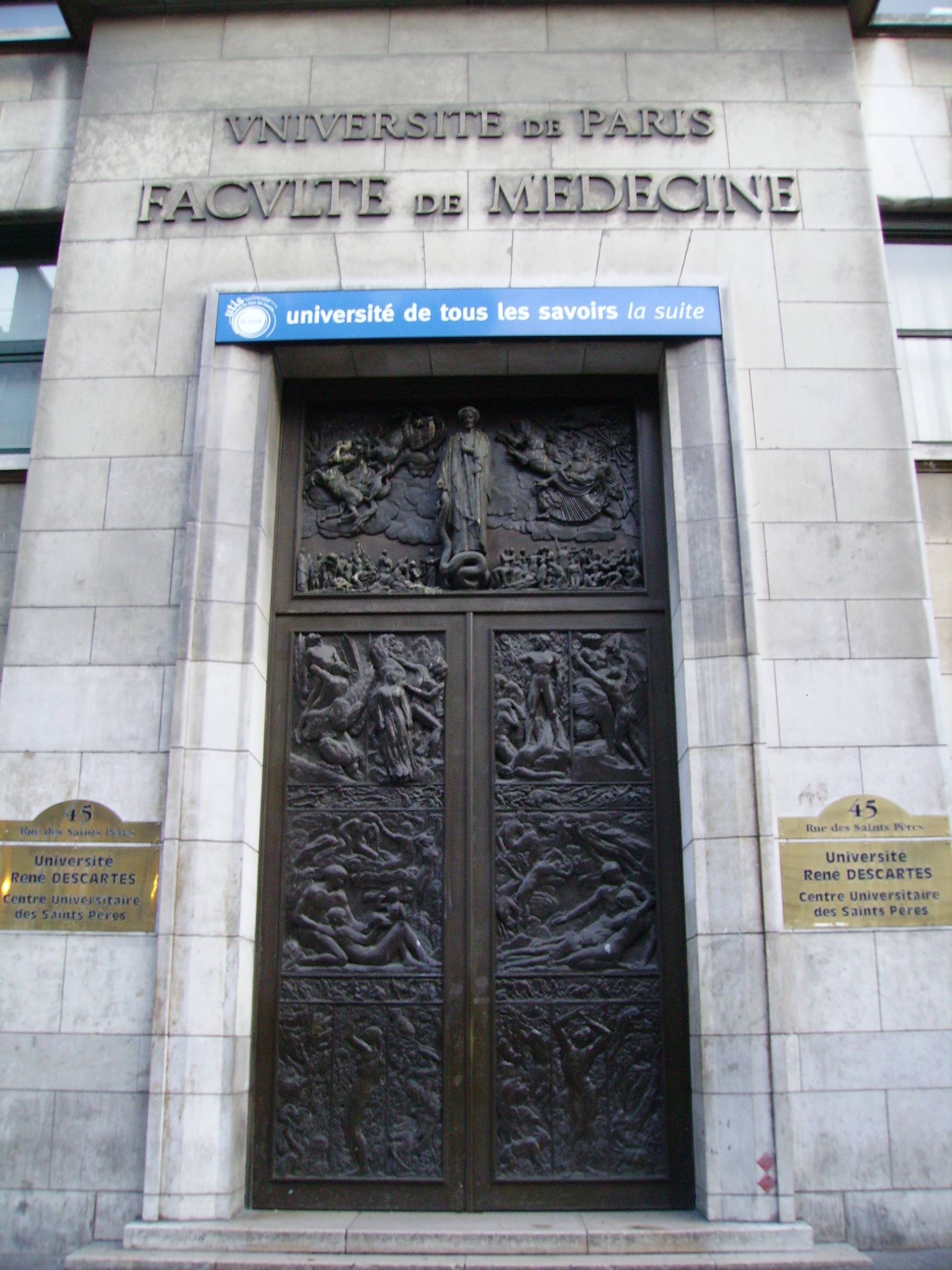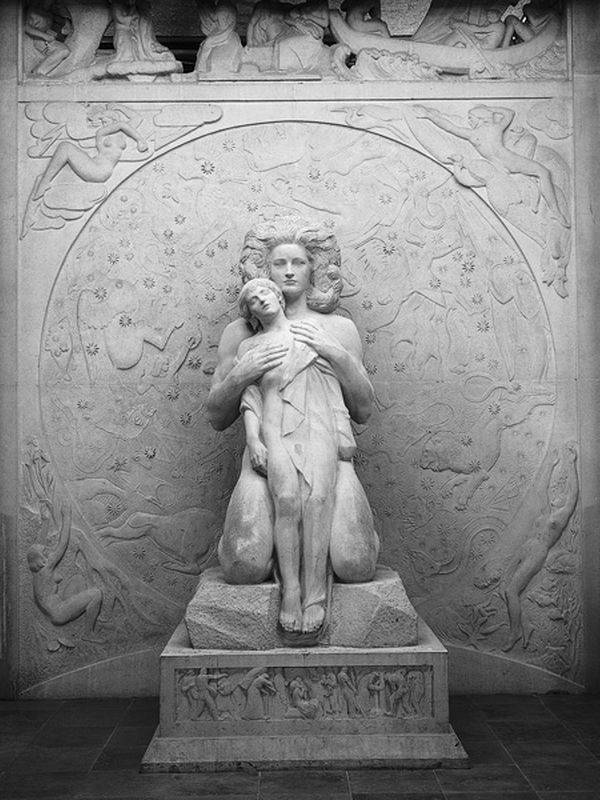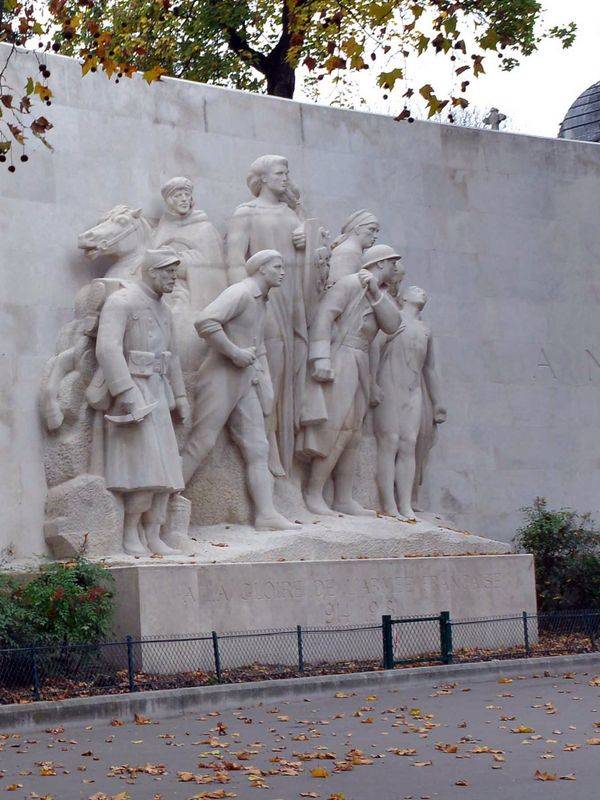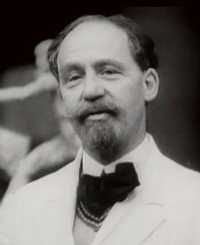
Paul Landowski
Biographie
Paul Landowski is a famous French sculptor of the twentieth century. He is mostly known for sculpting Christ the Redeemer, on Mount Corcovado, in Rio de Janeiro, Brazil. He developed his art in accordance with the humanist ideas of his time and managed, at the end of his career, to obtain positions of responsibility in accordance with his interests.
Childhood and early studies (1875-1892)
Paul Landowski was born in Paris on June 1, 1875 of a mixed family, his mother being French and his father Polish. He attended high school at Rollin College where he learned about literary culture. He entered Hypokhâne in 1892 and met Henri Barbusse, with whom he maintained a strong friendship throughout his life. It is he who will inspire Landowski with the humanist breath that will emerge from his works. During his studies he became passionate about the great authors (Hugo, Shakespeare, Plutarch) who became models for him. During his younger years, he tries to find a way to orient himself. Thus we see him trying to write dramas in verse or draw.
Art studies (1893-1900)
In 1893 he enrolled in the courses of Jules Lefebvre in the Jullian Academy. Jules Lefebvre was a rigorous painter who taught using a technique that wanted to be close to perfection. This quest for perfection will remain in the mind of Landowski who, throughout his life, will have the will to do so when he does a work. With Lefevre, he learned to master the art of the nude as well as the portraits.
At the same time he carries out his first practical work. The professor of anatomy Louis-Hubert Farabeuf, who provides dissection courses at the School of Medicine, commissioned him to produce descriptive plates. It is this work that gives him great knowledge in the human body, knowledge that will later be used for his sculptures. It is also thanks to this that his sculptures will have a certain humanistic breath. Between 1895 and 1900 he studied at the Ecole des Beaux-Arts, following the teachings of the sculptor Louis-Ernest Barrias. These courses were profitable to him since he left this school with the Grand Prix of Rome for his work "David against Goliath".
He could then enter the Villa Medici, but it must be known that at that time Paul Landowski was an energetic young man who indulged in boxing. This purely personal passion made him perform two important works: "The Pugilist", as well as the "Fallen Boxer".
The years at Villa Medicis and the design of the temple of man (1901-1905)
Paul Landowski entered the Villa Medici for the next four years. There he performed several major works: "The Orange Thief", "Le Fakir", "Bedouin à la jug", "Les portuses d'eau blind", etc. Some of these works are Maghreb subjects, it is due to the few trips that he made during those years, especially in Tunisia, then in ancient Italy which was a source of rational inspiration.
During this period his sculptures were of a rather classical style. They are characterized by the quality of the representation of the movement and the realism that emerges from it. But these sculptures were small, and he already imagined a much larger work. he imagined a place to the glory of man, in conformity with his will to put forward the current that will later be called humanism. He imagined a temple. It is Paul Valery who will give it a name: The temple of man.
The temple of man was, in his mind, an artistic place magnifying the people, the sculptures to be installed there had to be related to the greatness of the main idea, that of humanity in the broad sense. His sculpture "Le Rhapsode", made in 1905, was already in this spirit and served as a central figure for the "sons of Cain", a work exhibited at the Salon des artistes françaises in 1906 and which received a warm welcome from the critics who saw in Paul Landowski a hope of French sculpture. The way was then free to move on to the concrete realization of the temple of man.
The first humanist works (1906-1914)
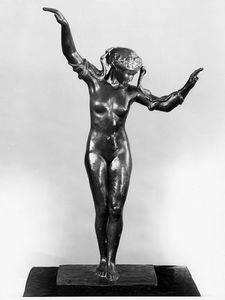
La danseuse aux serpents
At the end of the Villa Médicis Paul Landowski moved to Boulogne-Billancourt in 1906 with a series of artists working in various fields. It was during these years that his celebrity was born thanks to the delivery, in 1909, of "To the artists whose name was lost", a sculpture that will be installed under the dome of the Pantheon.
He then worked on various projects while putting his hand at his temple of man. He wanted it to be a kind of story told by man on Earth, from antiquity to the nineteenth century. His "Sons of Cain" were, in all logic, to be found in the forecourt of the temple. They were inspired by three young Tunisians met during the journey on the spot, marching "fraternally united, without any sentimentality". His other works are, for example, "L'Architecture" by Reims, "La danseuse aux serpents", "Monument de la Réformation", in Geneva (which he will make with Henri Bouchard).
War and its consequences on its work (1914-1920)
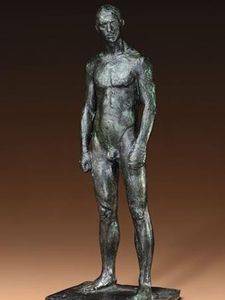
Le pugiliste
Then came the first world war. Paul Landowski is called to the banners and acts as a soldier in the fighting. He comes back alive and decorated with the cross of war. From this experience he keeps difficult memories from which will emerge the idea of specializing in the sculpture of monuments to the dead. It is probably the encounter of his trade and his military experience that pushed him in this direction, all cemented to the concepts of humanism to which he has always adhered.
Still, he built a whole series of monuments to the dead, the greater part in a sober style. For example, he was awarded the "monument to the glory of the hospitals of Paris", which is nowadays in the Hôtel Dieu (1921), the "Monument de la Victoire" in Casablanca (1924), the " of Algiers "(1928), the" Monument to the Dead of the Normal School Superior ", and especially" the Ghosts ", a very beautiful set of 8 giants each of 8 meters high which was placed on the hillock of Chalmont where the Battle of the Marne took place (Monument set up in 1935). These works are not all of great successes, some are of a quality little in accordance with what will be able to do the artist thereafter. But they are for him a source of inspiration through which he highlights themes such as heroism (especially on the two monuments he made in North Africa), the advance of humanity or the mother tie -child.
It was also at this time that Landoski realized some of these outstanding works: the "three allegories in stone" destined for the Piratini palace, in Porto Alegre (Brazil), the "Bedouin with the jug", the Hymn to the 'aurora', which was supposed to be placed in the temple of man, then many busts, funerary stones, and always monuments to the dead (public commissions).
The heroic period and the abandonment of the temple of man (1920-1933)
1920 is the year during which Paul Landowski obtains his legion of honor (It receives it the 8 of August). He was commissioned 8 years later, April 30, 1928. This distinction is part of his vision of the greatness of the human being and he then tackles an underlying theme until then in his works: The exploit through different disciplines . In 1920 he installed a monument to the glory of Wilbur Wright and the forerunners of aviation (1920), sport inspired him, he applied his own sport, boxing, and realized a beautiful sculpture entitled simply " The boxer "that he presents at the 9th Olympic Games of art of Amsterdam. He won the gold medal in the sculpture category. In the same theme follow the "Fallen Boxer", and the "Pugilist" which combines a real character and an antique style. Then in 1922 the Swedish Tourist Board asked him to sculpt the international ski cup, Landowski curiously chose to represent Herakles and the doe with brazen feet.
Saint Geneviève protecting Paris, which today stands at the entrance to the Tournelle bridge (1928), the "Bouclier aux morts", in the 16th arrondissement town hall, still in Paris ( 1929), the mausoleum of Sun Yat Sen ", in Nanjing (China, 1930), but above all Landowski advanced his project as a temple of man. In 1925 he exhibited at the Arts Décoratifs a model of his future temple which is then consisting of four opposite walls, two doors and a forecourt, the two doors are the door of science and the door of Psyche, they lead to the square in the center of which stands the "Son of Cain", a work already realized. The four walls were supposed to receive the monumental statues of 8 meters high centered on the 4 Prometheus themes, religion, legends and hymns. Each of these walls was to receive bas reliefs in connection with the theme: Christ crucified , Prometheus chained, the Hindu Vedas of the " Hymn to the dawn, the Canticle of the creatures of Saint Francis, etc.
The temple of man must be a place of meditation and meditation. It had to be public, containing exhibition rooms, conference rooms, a library, a cinema. The buildings were designed with international architects: Taillens, Bigot and Laprade. He had to extend the axis of the Champs-Élysées between Porte Maillot and La Défense, but in the end it was never realized.
Les fonctions officielles (1933-1944)
In 1933 Landowski took the direction of the Académie de France in Rome, commonly known as "Villa Medici". Thus begins its directorial period. He left his post in 1937 and took charge of the School of Fine Arts in the wake of which he tries to direct the teaching towards the social role of the artistic field. He also experimented with his students the teaching of simultaneous arts, architecture, sculpture and painting, where previously each art was separated. He believes that sculpting without taking into account the precepts of painting or, worse, architecture and heresy. Only the synthesis of the 3 arts allows the artist to flourish and the success of artistic projects.
Landowski is also continuing his work. If his temple of the man is constantly modified, it responds to orders from the city of Paris: the "statue of Montaigne", put street of the Schools (1934), the bas reliefs of the Fountains of the gate of Saint Cloud, the tomb of Marshal Foch are all works of Landowski. It is gradually gaining an international reputation. In 1928 he had worked for China. In 1931 it was Brazil who presented himself to him in the person of da Silva Costa who asked him to carve his Christ Redeemer who was to be placed at the top of the Corcovado, a hill dominating Rio. It is undoubtedly his most famous work, but it is also originality in that he made the clay statue (in several rooms, since it is a monumental statue) and sent it to the Brazil where they were reproduced in concrete. Paul Landoswki is the author of a statue he has never seen since he never set foot in this country!
In 1941, he participated with Paul Belmondo and André Derain in the "Voyage à Berlin". It was a German tour with the Nazi authorities, which had invited many European artists to collaborate intellectually with Germany. Considered suspect, the participants of this trip were worried during the purge process made at the liberation, suspected of collaborating with the enemy. But they were laundered, succeeding in proving that the purpose of such a journey was more to obtain the liberation of the students of the School of Fine Arts and to try to limit the German intervention in the artistic field than to really collaborate to the Goebbels project to bring about a new Europe.
His last works (1944-1961)
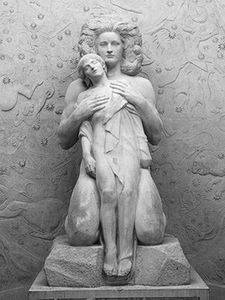
Le retour éternel
At the end of the war Paul Landowski will continue his project of the temple of man, but without succeeding in making it realize. He will have to abandon his idea definitively and his works already realized will remain in the places that already welcomed them. Thus the "Sons of Cain" are always visible in the garden of the Tuileries. The "Gate of Science" is the entrance to the new medical school of Paris, and "Hymn to the Dawn", is at the Museum of the Thirties. It was part of the Wall of Hymns.
He will also scuplage a "Michelangelo" 3 meters high and giving an impression of will, a "Fall of Icarus", the "four Cambodian dancers". In 1956 he realized "Le Retour éternel" at the Columbarium of Père Lachaise. This sculpture echoes the monuments to the dead of the 1920s, a period during which he put forward the link between a mother and her child. This "eternal return" takes up this theme which then appears a bit like a testamentary work.
Paul Landowski died on March 31, 1961 at his home in Boulogne-Billancourt. He was 85 years old.
Private life
Paul Landowski is from a Polish family by his father and French by his mother. He is the grandson of Henri Vieuxtemps, composer and violinist. He got married twice. A first with Geneviève Nénot (1888-1911) with two children: Nadine Landowski (1908-1943, painter) and Jean Max Landowski (1911-1943), and a second with Amélie Cruppi, of which he will also have two children, Marcel Landowski (1915-1999, musical teacher) and Françoise Landowski-Caillet (1917-2007, painter and pianist). The family has been in the artistic field for several generations.
Works of Landowski
Here is a list of works by Paul Landowski, mostly sculptures. This list is not exhaustive but almost. According to this man, some of these sculptures are grandiose, others modest, but all tend towards a humanism which he has sought to reproduce, in relation to the idea of his time that an artist owes himself to have a social role.
Click on the titles for a description and sometimes a photo of the sculptures that Paul Landowski did in the year indicated.
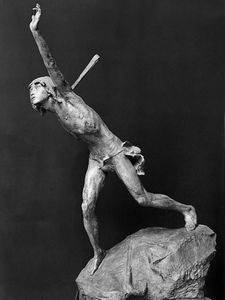
David against Goliath
David against Goliath
This David against Goliath is the first recorded work of Landowski. It is a patinated plaster depicting the legendary fight between the giant Goliath and the man David. It is this statue that made him get the Grand Prix of Rome. It is kept in the museum of the 30s, in Boulogne-Billancourt.
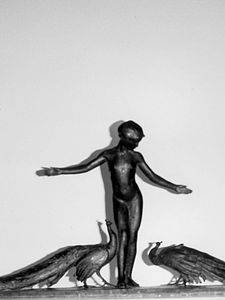
The charmeuse of peacocks
The charmeuse of peacocks
"The Peacemaker" is a sculpture 1m50 long by 60 high, in 3 parts. She represents a woman and 2 peacocks placed on both sides. It is a representation in bronze and cast iron.
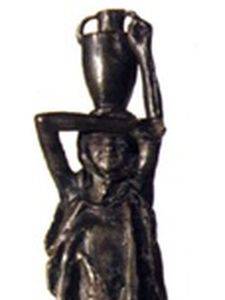
Bedouin with jug
Bedouin with jug
This is another modest sculpture of Landowski, it is 40cm high and 14 wide. It is cast iron and bronze and is currently in the Landowski Museum. It is a direct result of the artist's trip to Tunisia during his studies.
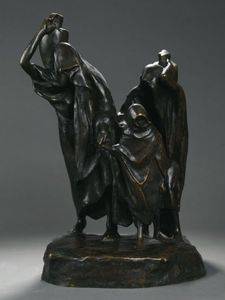
The blind water carriers
The blind water carriers
"Blind Water Carriers" is a set of 3 advancing grouped characters. It is a small sculpture expressing the progress in life despite the difficulties. It is exhibited in the museum of the 30s, in Boulogne-Billancourt.
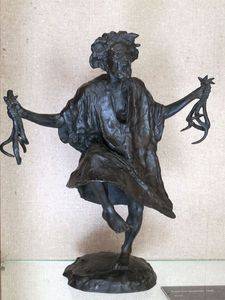
The snake fakir
The snake fakir
It is about a work inspired by the trip in Tunisia that makes the artist. He shows a man holding in his hands two groups of four snakes. The sculpture is in bronze.
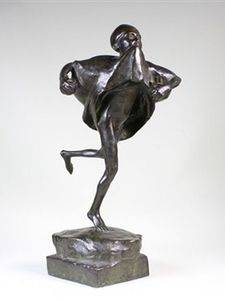
The thief of oranges
The thief of oranges
"The thief of oranges" is a small statue made in 1903. It is characterized by the quality of its impression of movements and that it is a little more stylized than the others, nevertheless of the same period.
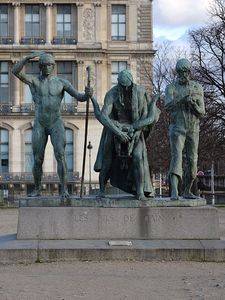
The sons of Cain
The sons of Cain
"Cain's sons" is a sculpture of 3 characters in real size. We see Jabel, the shepherd with a skull of cattle walking, Jubal, the poet, on his right, and Tubalcain, the blacksmith, on his left. It is made of bronze and is nowadays in the Jardin des Tuileries in Paris.
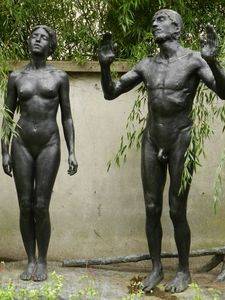
The anthem at dawn
The anthem at dawn
"The Hymn to Dawn" is a female and male plaster nude. It is visible at the Museum of the Thirties, in Boulogne-Billancourt. The photo opposite is a bronze reproduction.
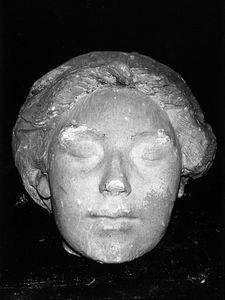
Woman's head
Woman's head
This woman's head seems to be more of a study than a work in itself. It must be a part of the hymn at dawn, on the wall of Hymns, in his temple of man. It does not exist nowadays.
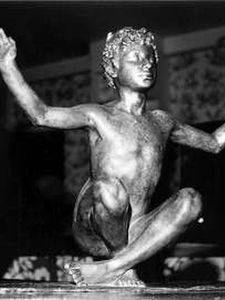
Soun dancer sacred
Soun dancer sacred
This sculpture is quite small, it represents a dancer.
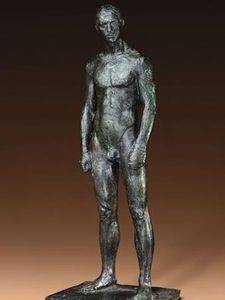
The pugilist
The pugilist
The pugilist is a small work. It is exposed to the museum of the 30s, in Boulogne-Billancourt.
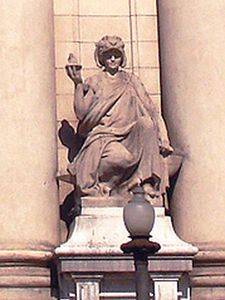
Industry and Agriculture
Industry and Agriculture
Industry and Agriculture is composed of two statues arranged on either side of the entrance to the courtyard of the Piratini Government Palace in Porto Alegre, Brazil.
Spring, Summer, Autumn, Winter, Abundance, Fortune
This work is installed in Madrid on the facade of one of the buildings of the Union.
Tribute to Joseph-Marie Jacquard
This statue pays tribute to Joseph-Marie Jacquard, the inventor of a modern loom. We can see place Jacquard in Saint-Etienne.
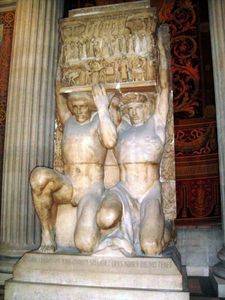
Artists whose name is lost
Artists whose name is lost
The final version of this statue is in stone, it was installed in the Pantheon in 1914. It followed a first version in plaster which was slightly different. This is a large statue that has been successful.
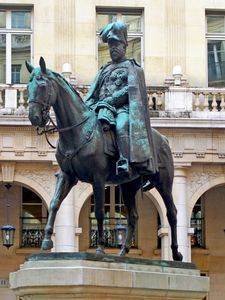
Equestrian statue of Edward VII
Equestrian statue of Edward VII
This equestrian statue of Edward VII is a very beautiful bronze sculpture. It is installed on Place Edward VII, in Paris, in the ninth arrondissement.
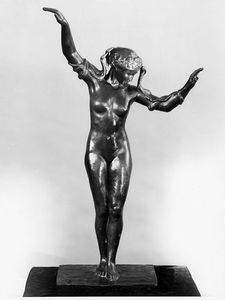
The snake dancer
The snake dancer
It is a fairly realistic statue that goes into the logic of Landowski's work, at that time.
International Monument to the Reformation
This monument, among the first of the artist, is a carved stone wall made with Henri Bouchard. He pays homage to the fathers of the Protestant Reformation. It can be seen in the city of Geneva, Switzerland.
Wilbur Wright Monument
This monument is an order, it was to salute the memory of Wilbur Wright. Made in 1917, it sits since in the city of Le Mans.
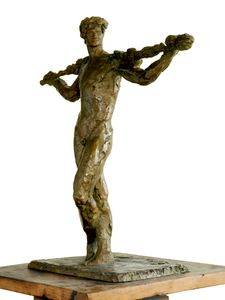
Dionysos
Dionysos
This statue of Dionysus supposed to be of modest size was never realized, it remained in the state of sketch. However, there is a preserved plaster at the Landowski Museum.
The fallen boxer
This work is well known in Landowski statuary. Illustrating the principle of humanism, she shows with realism a boxer getting up. It is on display at the Landowski Museum.
Monument to the dead of Barcelonnette
The city of Barcelonette, in the South of France, has a monument to the dead made by Paul Landowski.
To comforting Switzerland grateful France
This monument was installed in Schaffhausen, Switzerland.
Monument to Victory
This war memorial is dedicated to Casablanca soldiers who died during the First World War. Initially in Casablanca, it was recovered by the city of Senlis which put it place of the Third Houzard, in 1961.
Prometheus
No special information on this Prometheus.
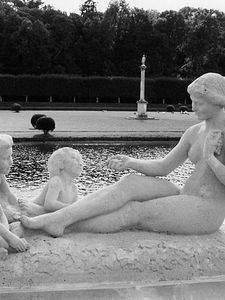
La Becquée
Country Concert and La Becquée
This monument is located near the basin of the Château de Voisins, in Saint-Hilarion. Small size (31 x 60 x 21 cm) it is a group made several times, sizes and materials varied. The original, terracotta, dates from 1919 and is located at the Landowski Museum. At Chateau de Voisins we find the stone version, much larger.
Monument dedicated to Professor Farabeuf
Paul Landowski has made a large number of statues dedicated to various characters. Here is Professor Farabeuf. The statue is at the University of Paris VI Pierre and Marie Curie
The music lesson
This is a plaster of which I have little information.
The song of songs
This bronze is one of Landowski's main works. It is a statue of woman at the center of the composition of the wall of Hymns. Reproduced many times in various materials, its initial size is only 1m10 in height. From this work, Landowski said:
I think I realized something that materializes a doctrine. A feeling expressed by a beautiful form, besides a work related to a big overall program. The final decorative effect obtained by starting from ideas, by the plastic expression of ideas, by their transformation into plastic themes. A great human breath giving rise to everything.
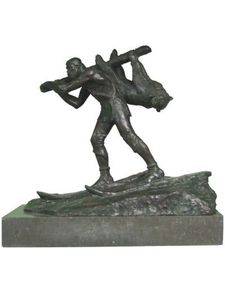
Prehistoric man
Prehistoric man
This small statue was made as a trophy for the Montefiore Cup, named after a skier who died early and gave his name to a famous race in Sweden.
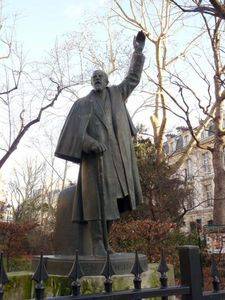
Monument to Paul Deroulede
Monument to Paul Deroulede
Paul Deroulede was a French writer and politician. It received the homage of a portrait realized by Paul Landowski in 1927. This monument is currently César-Cairo, in Paris.
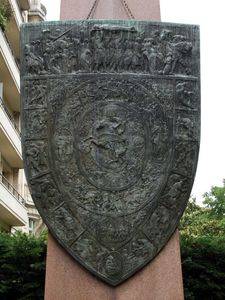
Shield to the dead
Shield to the dead
Another important work of Landowski, this monument measures 2.55m by 1.77m and represents a shield decorated with bas-reliefs telling the history of France. It is installed in the gardens of the town hall of the sixteenth arrondissement in Paris.
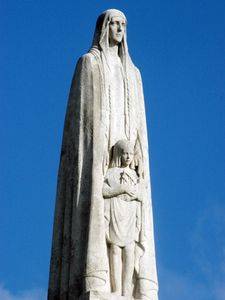
Sainte Genevieve
Sainte Genevieve
This statue is well known to Parisians, it is an emblem of the capital. She represents Ste Geneviève, protector of Paris, holding a boat in her arms while protecting a child. Large of 5,4m, it is perched on a pedestal end of 14m which makes the statue completely invisible of the walkers. This state of affairs lasts since the initial installation and was a source of conflict between the city of Paris, which decided this base, and the artist, who complained that we could not see it.
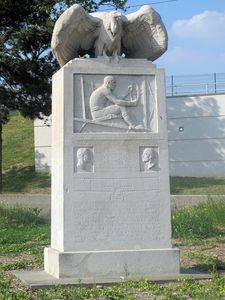
Henri Farman
Memorial to Henri Farman
This monument is in memory of Henri Farman. It is on the Issy heliport
Monument to the dead of Ault
It is in 1929 that Paul Landowski realized the war memorial of the city of Ault which is in Somme.
The Pavois
The Pavois is a monument to the Franco-Algerian fraternity. He is in Algiers. Its purpose was to mark the ties that had bound the two countries during the First World War.
Clément Ader Monument
It is in Muret, near Toulouse, is this monument to the glory of the aviator Clément Ader.
Sun Yat-sen mausoleum
Little information about this artwork ... It is in the Sun Yat-sen mausoleum in Nanjing, Vietnam. There is a bronze replica at the Sun Yat-sen Museum in Taipei, Taiwan.
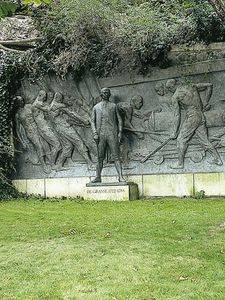
Amiral Grasse
Monument to the memory of Admiral Grasse
This is a monument to the memory of Admiral Grasse, it was offered by Kingsley Macomber to the city of Paris. It is boulevard Delessert near the gardens of Trocadero. The monument represents the admiral at the foot of a low relief on which is represented a battery of guns and the servants assigned to them.
Equestrian statue of Marshal Haig
This monument is impressive, it is nowadays on the avenue of General de Gaulle, in Montreuil-sur-Mer. The statue is real size bronze.
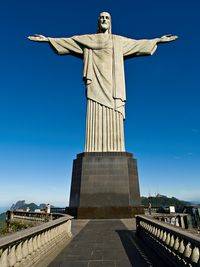
Christ the Redeemer
Christ the Redeemer
Christ the Redeemer is undoubtedly the most famous monument of all the work of Paul Landowski. This website is dedicated to him, so you have all the information on this site.
Tomb of the Darracq family
This is a large recumbent that has been installed since 1932 in the Père Lachaise cemetery. He was commissioned by the Darracq family.
Second Gérard Montefiore Cup
Paul Landowski realized the trophy celebrating the winner of the second Gérard Montefiore Cup. He represented a man and a tall mountain eagle.
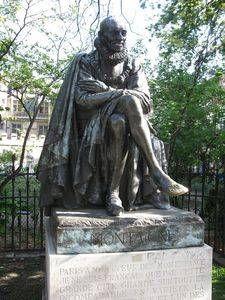
Montaigne
Montaigne
In love with the works of Montaigne, Paul Landowski finally made a statue of this character who was placed at the entrance of honor of the Sorbonne, rue des Ecoles. Marble statue, it was replaced by a bronze copy to protect it.
Bust of the Doctor Armaingaud
Arcachon is where this minor work by Landowski (if you can find his minor works). This is the bust of Dr. Armaingaud.
The ghosts
It is one of the major works of Paul Landowski, listed as a historical monument since July 31, 1934. It shows a group of 7 soldiers, each of them representing a weapon. The whole is 8m high and was made of stone. It is installed on the Chalmont hill in Oulchy-le-Château in the Aisne at the precise location where the fate of the Second Battle of the Marne was decided.
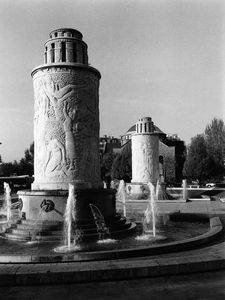
The sources of the Seine
The sources of the Seine
The "Sources of the Seine" are a set of bas-reliefs fountains of the door of Saint-Cloud. It is a large work (10 meters high and 4 in diameter), consisting of two fountains in the center of the square. These bas-reliefs are original insofar as it is one of Landowski's rare art deco compositions, the same style as that of Christ the Redeemer. They show the opposition between life in the countryside and in the city.
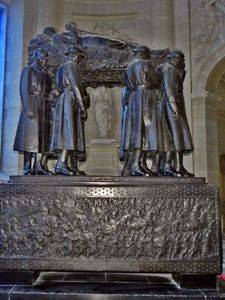
The tomb of Marshal Foch
The tomb of Marshal Foch
The tomb of Marshal Foch is in the Invalides. He realizes for this great man an adaptation of the "Tomb of the Soldier" which was one of his old projects. He realizes it in the form of 8 soldiers on the march, forming a scene of everyday life during the war. These statues are made of bronze, but initially they were meant to be marble. The museum of Luneville preserves the original plaster bas-reliefs.
PAX
PAX (Peace in Latin) is a monument made in honor of Aristide Briand, Nobel Peace Prize. He is in front of the Ministry of Foreign Affairs, in Paris (at the Quai d'Orsay)
Paul Adam Monument
This monument is found against the Trocadero Palace, avenue Albert-de-Mun. It is dedicated to Paul Adam.
The zodiac signs
The Zodiac Signs is a stone work located in the basement of the crematorium of the Père-Lachaise cemetery.
Nocturne
Nocturne, it is a small statue of 33cm high and 66 long and 30 wide representing a head of the woman of the monument to Fauré. Made of marble, it is kept at the Landowski Museum.
Shakespeare
This is a statue of Shakespeare, the British playwright.
Michelangelo at work
Michelangelo at work, is curiously a self-portrait of Landwoski. It is in the Museum of the Thirties.
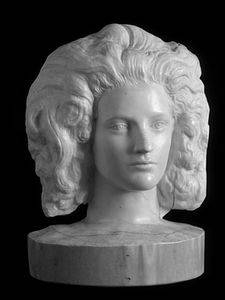
Pandore
Pandore
Pandora is an ivory statue, a material little used by the artist. She will become a model for the head of the "Eternal Return", Landowski's monument-testament of the Père Lachaise Colombarium.
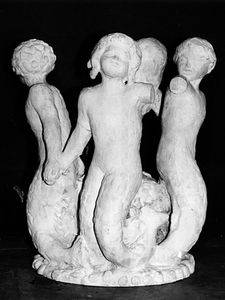
The round of sirens
The round of sirens
The mermaids' round is a statue of Landowski.
Parvatti dance
The Parvatti dance is a statue of Landowski.
The dance of seduction
The dance of seduction is a statue of Landowski.
The dance of purity
The dance of purity is a statue of Landowski.
Dance of Durga or bow dance
Durga's dance is a statue of Landowski.
Icare
Icare is a statue of Landowski.
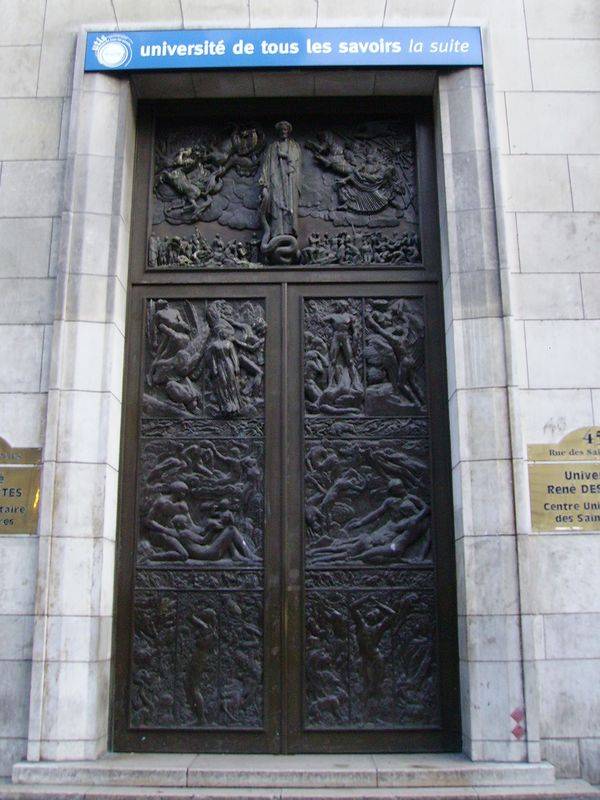
Faculty of Medicine door
Faculty of Medicine door
This door was originally intended for the Temple of Man, a dream of Landowski who made a large number of works for him. However, this door was installed on the new factual medicine, 45 rue des Saints-Pères.
Georges Heuillard monument
This statue of Georges Heuillard is in stone and bronze. It was inaugurated on November 14, 1953 at Neuf-Marché, in Seine-Maritime.
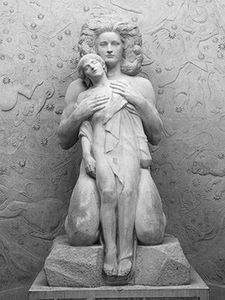
The eternal return
The eternal return
This work is testamentary. It represents as often a statue and a bottom carved bas-reliefs in the theme of death. Today it is located in the basement of the crematorium of the Père-Lachaise cemetery. The original plasters are kept in the museums of Boulogne-Billancourt.
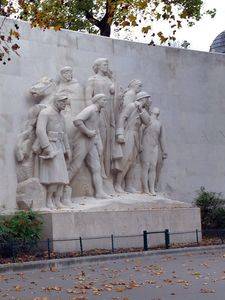
Monument to the glory of the French army
Monument to the glory of the French army
This is a group that was to be at the center of a large ensemble, along a wall in the Passy cemetery. The idea was to make an equestrian ensemble but this project, which lasted too long, was finally abandoned. All that remains is this group to the glory of the soldiers of the 1914-1918 war. It is nowadays Place du Trocadero.
Thousand and one Night
Only a plaster was made of this work whose name is evocative.
See also:






